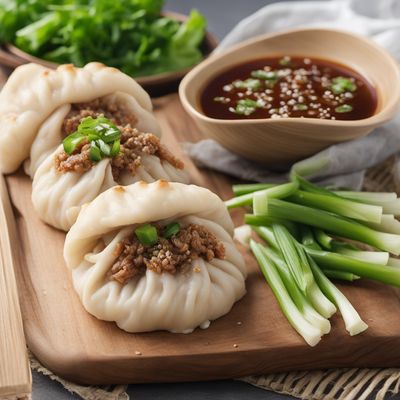
Recipe
Cochinita Pibil - Japanese Style
Yakiniku-style Cochinita Pibil: A Fusion of Mexican and Japanese Flavors
4.8 out of 5
In this adaptation of the traditional Mexican dish Cochinita Pibil, we bring together the bold flavors of the Yucatan Peninsula with the delicate nuances of Japanese cuisine. The result is a mouthwatering fusion of tender, slow-cooked pork marinated in a blend of aromatic spices, citrus, and soy sauce. Get ready to embark on a culinary journey that combines the best of both worlds.
Metadata
Preparation time
20 minutes
Cooking time
2-3 hours
Total time
2 hours 20 minutes - 3 hours 20 minutes
Yields
4 servings
Preparation difficulty
Medium
Suitable for
Omnivore, Gluten-free, Dairy-free, Nut-free, Low-carb
Allergens
Soy
Not suitable for
Vegan, Vegetarian, Paleo, Keto, Halal
Ingredients
While the original Cochinita Pibil is traditionally cooked in a banana leaf and flavored with achiote paste, this Japanese adaptation incorporates soy sauce and Japanese spices to infuse the dish with a unique umami flavor. The cooking method remains the same, with the pork slow-cooked until it becomes tender and succulent. We alse have the original recipe for Cochinita pibil, so you can check it out.
-
2 pounds (900g) pork shoulder, thinly sliced 2 pounds (900g) pork shoulder, thinly sliced
-
1/4 cup (60ml) soy sauce 1/4 cup (60ml) soy sauce
-
2 tablespoons (30ml) rice vinegar 2 tablespoons (30ml) rice vinegar
-
2 tablespoons (30ml) mirin 2 tablespoons (30ml) mirin
-
2 tablespoons (30ml) sake 2 tablespoons (30ml) sake
-
4 cloves garlic, minced 4 cloves garlic, minced
-
1 tablespoon (15g) ginger, grated 1 tablespoon (15g) ginger, grated
-
1 tablespoon (15g) brown sugar 1 tablespoon (15g) brown sugar
-
1 teaspoon (5g) ground cumin 1 teaspoon (5g) ground cumin
-
1 teaspoon (5g) ground coriander 1 teaspoon (5g) ground coriander
-
1 teaspoon (5g) paprika 1 teaspoon (5g) paprika
-
1/2 teaspoon (2.5g) chili powder 1/2 teaspoon (2.5g) chili powder
-
1/2 teaspoon (2.5g) black pepper 1/2 teaspoon (2.5g) black pepper
-
1/4 teaspoon (1.25g) cinnamon 1/4 teaspoon (1.25g) cinnamon
-
1/4 teaspoon (1.25g) nutmeg 1/4 teaspoon (1.25g) nutmeg
-
1/4 teaspoon (1.25g) cloves 1/4 teaspoon (1.25g) cloves
-
2 tablespoons (30ml) vegetable oil 2 tablespoons (30ml) vegetable oil
-
1 onion, thinly sliced 1 onion, thinly sliced
-
2 green onions, chopped 2 green onions, chopped
-
Fresh cilantro, for garnish Fresh cilantro, for garnish
Nutrition
- Calories (kcal / KJ): 350 kcal / 1465 KJ
- Fat: 15g (Saturated Fat: 4g)
- Carbohydrates: 10g (Sugars: 4g)
- Protein: 40g
- Fiber: 2g
- Salt: 1.5g
Preparation
-
1.In a bowl, combine soy sauce, rice vinegar, mirin, sake, minced garlic, grated ginger, brown sugar, cumin, coriander, paprika, chili powder, black pepper, cinnamon, nutmeg, and cloves. Mix well to create the marinade.
-
2.Place the thinly sliced pork shoulder in a large ziplock bag and pour the marinade over it. Seal the bag and massage the marinade into the meat. Refrigerate for at least 4 hours, or overnight for best results.
-
3.Preheat the oven to 325°F (160°C).
-
4.Heat vegetable oil in a large oven-safe skillet over medium-high heat. Add the sliced onion and sauté until translucent.
-
5.Remove the marinated pork from the ziplock bag, allowing any excess marinade to drip off. Add the pork to the skillet and sear on all sides until browned.
-
6.Cover the skillet with a lid or aluminum foil and transfer it to the preheated oven. Bake for 2-3 hours, or until the pork is tender and easily shreds with a fork.
-
7.Once cooked, remove the skillet from the oven and let the pork rest for a few minutes. Use two forks to shred the meat.
-
8.Serve the Yakiniku-style Cochinita Pibil over steamed rice, garnished with chopped green onions and fresh cilantro.
Treat your ingredients with care...
- Soy Sauce — Use a low-sodium soy sauce if you prefer to reduce the overall saltiness of the dish.
- Rice Vinegar — If you don't have rice vinegar, you can substitute it with apple cider vinegar or white wine vinegar.
- Mirin — If you can't find mirin, you can replace it with a combination of equal parts of rice vinegar and sugar.
- Pork Shoulder — Choose a well-marbled pork shoulder for the best flavor and tenderness.
- Cilantro — If you're not a fan of cilantro, you can substitute it with fresh parsley for a milder herb flavor.
Tips & Tricks
- For an extra layer of flavor, marinate the pork overnight to allow the spices to penetrate the meat.
- If you prefer a spicier dish, increase the amount of chili powder or add a pinch of cayenne pepper to the marinade.
- Serve the Yakiniku-style Cochinita Pibil with a side of pickled vegetables to add a refreshing contrast to the rich flavors.
- Leftovers can be used to make delicious tacos or sandwiches the next day.
- If you don't have an oven-safe skillet, transfer the seared pork and onions to a baking dish before placing it in the oven.
Serving advice
Serve the Yakiniku-style Cochinita Pibil over steamed rice for a complete meal. Add a side of pickled vegetables or a fresh salad to balance the richness of the dish. Garnish with chopped green onions and fresh cilantro for a pop of color and added freshness.
Presentation advice
Arrange the shredded pork on a bed of steamed rice, creating a mound in the center of the plate. Drizzle any remaining cooking juices over the meat for added flavor. Garnish with a sprig of fresh cilantro and a sprinkle of chopped green onions. Serve with a side of pickled vegetables for an attractive and appetizing presentation.
More recipes...
For Cochinita pibil » Browse all
For Mexican cuisine » Browse all
More Mexican cuisine dishes » Browse all

Chiles de la Sierra
Chiles de la Sierra is a traditional Mexican dish that is made with a variety of chiles and spices. The dish is typically served as a side dish or...

Sopa de tortilla
Sopa de tortilla is a traditional Mexican soup that is made with chicken, vegetables, and tortilla chips.

Enchiladas Potosinas
Potosinas-style enchiladas
Enchiladas Potosinas are a traditional Mexican dish that originated in the state of San Luis Potosi. They are made with corn tortillas filled with...
More Japanese cuisine dishes » Browse all

Fukujinzuke
Fukujinzuke is a Japanese condiment made from a variety of vegetables pickled in soy sauce and mirin. It is commonly served with Japanese curry.

Botamochi
Botamochi is a traditional Japanese sweet made from glutinous rice and sweet red bean paste. It is typically served during the spring season and...

Kininaru ringo
Kininaru ringo is a Japanese dessert made from apples and sweet red bean paste. It is a popular snack during the fall season.










